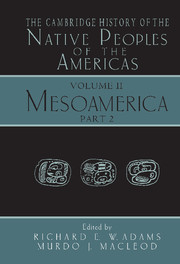Book contents
- Frontmatter
- 12 Mesoamerica Since the Spanish Invasion: an Overview
- 13 Legacies of Resistance, Adaptation, and Tenacity: History of the Native Peoples of Northwest Mexico
- 14 The Native Peoples of Northeastern Mexico
- 15 The Indigenous Peoples of Western Mexico from the Spanish Invasion to the Present
- 16 Native Peoples of Colonial Central Mexico
- 17 Native Peoples of Central Mexico Since Independence
- 18 Native Peoples of the Gulf Coast from the Colonial Period to The Present
- 19 The Indigenous Population of Oaxaca from the Sixteenth Century to the Present
- 20 The Lowland Mayas, from the Conquest to the Present
- 21 The Highland Maya
- Index to Part 2
- Map 12.1: A general map of Mesoamerica, showing major ancient, colonial, and modern population centers"
12 - Mesoamerica Since the Spanish Invasion: an Overview
Published online by Cambridge University Press: 28 March 2008
- Frontmatter
- 12 Mesoamerica Since the Spanish Invasion: an Overview
- 13 Legacies of Resistance, Adaptation, and Tenacity: History of the Native Peoples of Northwest Mexico
- 14 The Native Peoples of Northeastern Mexico
- 15 The Indigenous Peoples of Western Mexico from the Spanish Invasion to the Present
- 16 Native Peoples of Colonial Central Mexico
- 17 Native Peoples of Central Mexico Since Independence
- 18 Native Peoples of the Gulf Coast from the Colonial Period to The Present
- 19 The Indigenous Population of Oaxaca from the Sixteenth Century to the Present
- 20 The Lowland Mayas, from the Conquest to the Present
- 21 The Highland Maya
- Index to Part 2
- Map 12.1: A general map of Mesoamerica, showing major ancient, colonial, and modern population centers"
Summary
The nine chapters in this volume, all by mid-career or younger scholars, are a collective attempt to survey what is known of the history of Native American peoples in Mesoamerica since the Spanish invasion. Obviously, what we know about the various nations, groups, and regions varies widely. Nomadic peoples and those who leave behind little of their material cultures are generally less studied and less understood. The same can be said for peoples who did not write, either before or after the invasions, or about whom others wrote less.
Geographical definitions have been kept deliberately fluid. Mesoamerican frontiers, as classically defined, were extended, especially over what today would be called the Mexican north. Many of these areas, after all, interacted with, or felt influences from, the sedentary centers. Nor did the editor try to impose geographical boundaries – which would have been arbitrary anyway in many cases – among the various essayists. Probably, as independent and idiosyncratic scholars, most would have ignored these admonitions anyway. So there are some overlapping discussions, and some areas that, falling between two stools somewhat, no doubt do not receive their deserved attention. Nor did the editor try to impose thematic unity, which would have been another thankless task, simply asking that certain basic informational themes be covered. Thus each chapter has individual emphases and interpretations, something that should surely be considered not a fault but, rather, a window through which variety and debate can be illuminated.
- Type
- Chapter
- Information
- Publisher: Cambridge University PressPrint publication year: 2000
- 4
- Cited by



